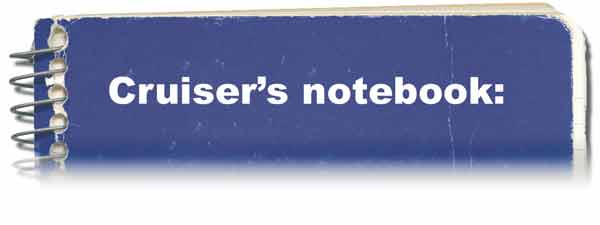

Sault Ste. Marie, Michigan
by Cyndi Perkins
Regionally known as “The Soo,” the
shipping crossroads of the Upper Great
Lakes is a must-see for any boater.
Whether you arrive by land or sea, the
history, scenery and recreational
opportunities on the shores of the St.
Mary’s River make this a superb vacation
destination. The historic and scenic
attractions of Michigan’s oldest city -
the third oldest city in the United
States - offers something for all ages.
And the boating facilities are first
class in value for dollars expended.
In our case, a stop in Sault Ste. Marie,
Michigan proved a welcome rest stop
after Chip Ahoy’s 35-hour
premiere leg of America’s Great Circle
Loop.
Packing and provisioning, not to mention
countless bon voyage parties, left us
exhausted but exhilarated as we
unplugged and untied from our seasonal
slip at Houghton County Marina in the
western Upper Peninsula on the morning
of Friday, Aug. 30, 2003. After more
than 10 years of planning and working
our keisters off, we were finally taking
our 1977 bluewater cruiser where she was
built to go - on a long, open-ended
voyage ultimately leading to salt water
and weather where the butter melts.
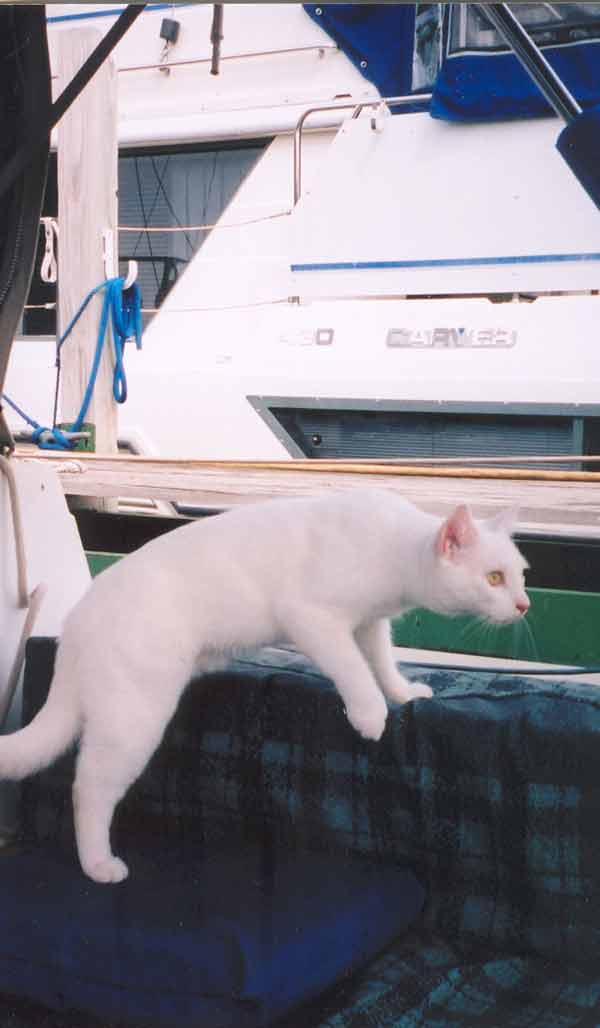 |
| Bleach the cat, aka “Bleachy Mon,” attends one of Chip Ahoy’s many bon voyage parties at our slip in Houghton County Marina. After a decade of work and planning, the dream to take an extended cruise was coming true. |
By 2:29 p.m. Saturday, we were wearily
celebrating Chip Ahoy’s marathon
blast east across Keweenaw Bay and Lake
Superior to Whitefish Point. Ahead of us
lay Whitefish Bay and the St. Mary’s
River, which feeds into Great Lakes
Huron and Michigan via the Straits of
Mackinac. The Soo was still four to five
hours away.
From more than 20 miles offshore, sand
beaches and dunes rimming the shore
floated hazily, a tan ribbon on the
distant horizon. The unclouded sun lent
an illusion of warmth. In actuality,
long underwear, wooly caps and gloves
were necessary.
Landlubbers are always curious about
what we do on such long offshore
passages. We read, listen to music and
tend to boat chores. Scott messes with
sail configurations, making minute
adjustments to get the most out of the
wind. We also spend hours simply
watching the water and the sky. If that
sounds boring to you, you are probably
not cut out to be a cruiser.
Our night passage across Lake Superior
is something I will always remember for
its clarity, beauty and discomfort. The
planet Mars outshone the moon, laying a
thick glade on the black, foam-licked
waves. Earlier, at dusk, our last
Superior sunset for the year produced an
amazing red sky that lingered behind a
fingernail moon. The pretty show in the
sky provided some consolation for the
damnable beam seas that had kicked in
around Point Abbaye as we left the
shelter of Keweenaw Bay. In a rude, long
goodbye, Lake Superior flung us about
all night in five-to-eight footers. We
were never in danger, mind you, it just
wasn’t pleasant.
I managed a 9 p.m.-12:40 a.m. watch and
Scott woke me at 5 a.m. - actually I had
to wake up my hand and other assorted
tingling parts before I could lurch off
the salon settee. Now I understand why
lee cloths are essential to hold the
sleeping sailor in her bunk. Temps were
39-40°F but we dress for the cold all
the time on this lake so that was
nothing new. To starboard, Marquette
shown brightly, with dimmer glows
marking Munising and Grand Marais. We
decided not to beat ourselves up with
any more all-nighters for a few weeks.
You tough them out and tend to forget
how much it took out of you - something
both sailing and childbirth have in
common. Thank God we had tied up for a
few hours to eat brunch at the lower
entry before we went out on the lake. We
were also able to scarf down some
outstanding smoked salmon with Brie and
crackers in the lee of the Huron Islands
before the 5-8 footers started cracking
us from the north again. Referring to my
log I notice I had to stop recording
information during this part of the trip
because even with seabands on I was
getting queasy. Waves subsided
throughout the afternoon and we motored
with the headsail up in more comfortable
conditions.
In late afternoon Saturday we entered
Whitefish Bay, where huge and natural
wave action combined with freighter slop
creates an unpredictable, often powerful
wake that demands respect and constant
attention at the tiller and charts.
Spotting markers can be difficult in
certain light and wave conditions and
first glances can be deceiving. Water
and radio towers ashore add to the
confusion.
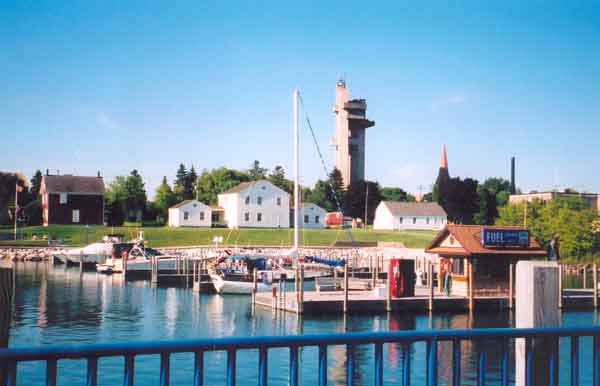 |
| George Kemp marina is a first-rate reasonably priced facility with all major attractions in walking distance. |
We looked behind us for one more glimpse
of “our” lake. It would be harder to say
goodbye to Superior if it wasn’t so
cold, and if she’d been kinder.
My anxiety rose as we passed from the
wide-open bay into the shipping channel
in early evening. Scott is familiar with
the locks. In fact, Chip Ahoy was
the first pleasure vessel to pass
through the locks in 1997, on her April
inaugural journey from Bay City,
Michigan in the Lower Peninsula to her
new home in the Upper Peninsula. The
confounding vista of belching stacks,
the towering International Bridge
linking the United States and Canada,
the concrete tunnels and metal gates was
new to me.
The traffic on the waterway is
intimidating and thrilling. Even with
our guidebook and chart diagrams, I felt
a little panicky about which lock to go
into. There are four locks on the
American side: The Davis, Poe, MacArthur
and now-closed Sabin locks. We radioed
the American Lockmaster on Channel 14,
which is used by both the American and
Canadian locks, to receive instructions.
After a half-hour wait idling near the
lock entrance the green light signaled
us into the MacArthur. Lock workers
handed us two lines, fore and aft,
affixed to cleats on the sidewalk/lock
platform. As the water was lowered and
Chip Ahoy dropped 21 feet we paid out
the lines.
The concrete walls steadily encased us,
as if the boat was in the throat of a
giant. Stationed at the bow, my hardest
task was pushing Chip Ahoy away
from the wall with a boathook to prevent
the mast spreaders from striking the lip
of the sidewalk. Locking down is less
turbulent than locking up, and we fell
smoothly in a matter of minutes. It was
weird to see all the tourists on the
observation platform gawking and taking
photos after our two days of complete
solitude on the lake. Plus we had a
triple-decked tour boat in front of us
in the lock. I was happy we weren’t
required to lock through with a
freighter, although it was a treat to be
up close and personal with our neighbor
in the next lock, the freighter Bourland,
which we have often crossed paths with
(never this close!) in the shipping
lanes off the Keweenaw Peninsula.
We kept our starboard bumpers out and
deployed fenders on port as well to be
prepared for any docking situation at
the George Kemp Downtown Marina, a short
distance from the locks and easily
recognized by the adjacent Valley Camp
museum ship. The harbormaster came out
to meet us on the fuel dock and assisted
us in entering our slip. Wow, it was
great to arrive somewhere. We’ll have no
watch schedule and no trouble sleeping
on this night.
The tolling church bells woke us Sunday,
and after sausage and eggs over easy we
decided to walk around town. The marina
is in the heart of the downtown tourist
district and Ship Canal Park is close
by. The weathered historic homes include
a little red house occupied by Bishop
Baraga, “the Snowshoe Priest,” who
ministered to Native Americans across
the region. Back in the Copper Country,
his giant statue and shrine attraction
is a familiar landmark and it was nice
to see a little touch of home in a
strange place.
Out front of the marina, dozens of
salmon fishermen jockeyed for position
in a tournament, trolling off boats and
casting from the spacious public
boardwalk and adjoining riverbank. We
witnessed several good catches and can
attest to the high quality of fishing.
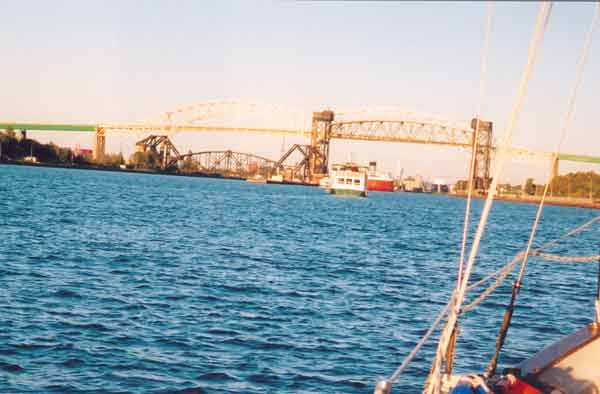 |
| Chip Ahoy idles in front of the American locks, awaiting permission to lock through. In major shipping areas, commercial traffic takes priority over recreational vessels, so waits are common. The green tour boat ahead of us is also standing by for the green light. |
The shopping district on Portage Street
near Locks Park is very Mackinac
Island/Wisconsin Dells, a street
carnival overflowing with kitschy
knick-knacks, fudge, t-shirt shops and
nautical trappings. It’s a great place
to browse and nibble. We stopped at a
convenience store where Scott bought a
lotto scratch ticket and won $40. We
blew his windfall on a restaurant
dinner. The majority of the time we cook
on the boat. Scott enjoys whipping up
gourmet meals and I enjoy consuming
them. But part of the cruising adventure
is tasting the local specialties. We
weren’t disappointed at Goetz’s Lock
View Restaurant. Scott’s walleye and my
perch were excellent, as were the
sourdough rolls and friendly service. We
decided we owed the harbormaster a
thank-you for his recommendation.
Labor Day Monday, Sept. 1, marked the
first Monday in a long time that we
didn’t have to travel back where we came
from. Moving forward was wonderful. I
don’t know how many times we’ve wished
aloud “Let’s just keep going!” We can
hardly believe we are finally able to
sail our bluewater cruiser into waters
new to us.
We pulled out of Kemp Marina around 8
a.m., skirting dozens of salmon fishing
boats. The St. Mary’s is lovely, and
blessed be, well marked. I am reminded
of the harbormaster’s rhyme “Green to
green and red to red, all is cool,
proceed ahead.” Our next stop is the
village of Detour at the far eastern end
of the Upper Peninsula, leading to the
Straits of Mackinac and Lake Michigan.
Cyndi Perkins is a freelance writer
and full-time cruiser traveling with her
husband, Scott, aboard their 32-foot
DownEast sailboat Chip Ahoy. The couple
completed America’s Great Circle Loop -
a nine-month 6,000-mile journey - on
June 4, 2004. In summer 2005 they will
be leaving their Upper Peninsula
homeport of Houghton, Michigan to
explore Lake Superior’s Canadian north
shore before heading south again on a
cruise with an open-ended destination.
Cyndi will be sharing top northern and
Midwest destinations with readers in her
regular “Cruiser’s Notebook” feature.
| The Soo
Locks area celebrates 150
years of operation in
2005, making for an
eventful summer. Expect a
lot of company if you
visit during the
Sesquicentennial “Lockfest,”
a week of celebrations
leading up to spectacular
Independence Day
fireworks on July 1st in
Canada and July 4th in
Michigan, not to mention
the colorful and
awe-inspiring grandeur of
a Native American powwow
on July 3rd. For more information on exhibits, festivals, historical sites and other coming attractions, visit the saultstemarie.com website. George Kemp Downtown Marina 906-635-7670, 866-635-7670, www.kempmarina.com on the Internet. The well-run, immaculate marina has 56 slips as well as one mooring for a 75-90 foot vessel. It is a Michigan State Waterways sanctioned marina offering a reasonable state-set fee schedule. Our slip rate in August 2003 was $30 per night. Rates have probably gone up a bit, but nothing shocking. Please note that the Charles T. Harvey Marina, a shallow-draft facility farther down the river, will no longer be serving transient vessels. Boat Launches Ashmun Bay Park is listed as the only major boat launch into the Upper St. Mary’s River. There are two small-boat launches at Aune-Osborn Park as well as 100 camping sites with electrical hookups. Contact the Kemp Marina if you are unsure about where to launch. Transportation There’s dial-a-ride, cab, Rent-A-Wreck and airport auto rental service available, as well as shuttles to area casinos. Marina guests may use one of the courtesy bikes, available on a first-come first-served basis. Locking through You can observe the entire locking process at the visitors center, but there’s nothing like doing it yourself, at least if you’re a boater. If you wish to lock through, just so you can say that you have, hail both Canadian and U.S. locks on VHF Channel 14 and await instructions. Locking through is toll-free and you can pass through the Canadian lock without dealing with any customs issues. Other essentials The marina has an extensive list of frequently called numbers including marine service, repair and equipment outlets. If you need groceries, you should plan on traveling by motor vehicle. |
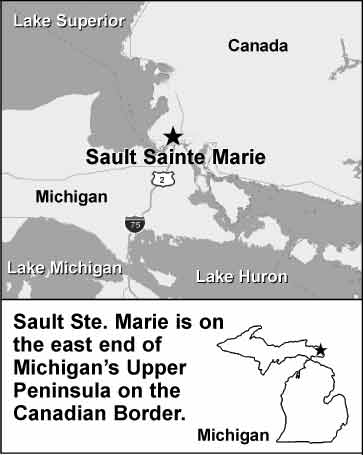 |